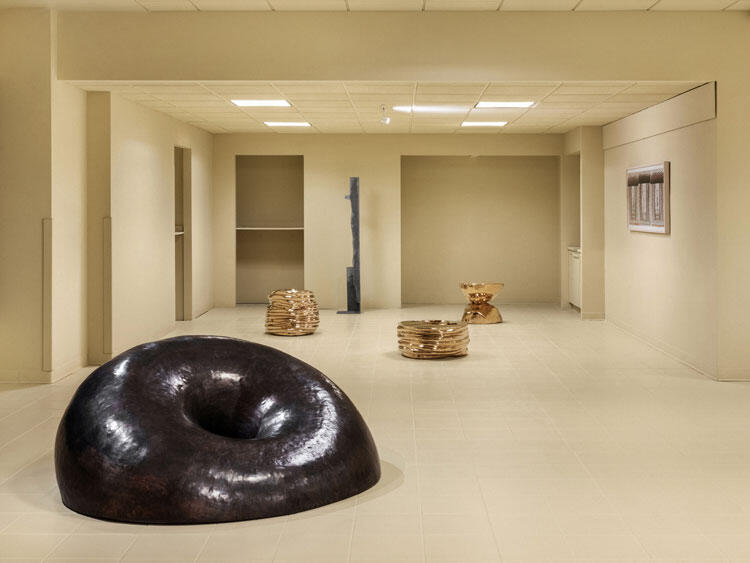‘Intervención/Intersección’ Brings Mexican Art Back to Rockefeller Center
The nomadic gallery MASA showcases a group exhibition of Mexican and Mexico-based artists, designers and architects that intervene the iconic site once again
The nomadic gallery MASA showcases a group exhibition of Mexican and Mexico-based artists, designers and architects that intervene the iconic site once again

Nearly 100 years since Diego Rivera’s Man at the Crossroads (1933) fresco was ignominiously chiselled from its wall, Mexican and Mexico-based artists, designers and architects are once again intervening at the Rockefeller Center. The group exhibition ‘Intervención/Intersección’ brings together 22 artists and collectives who have taken over the Rink Level Gallery and the Center Plaza. Curated by Su Wu and presented by Mexico City-based gallery MASA – a nomadic organization that bridges art and design – the project invokes the fluidity of history and storytelling to explore moments of fracture, rehabilitation and repair.
‘Many artists in the exhibition explore unrealized or damaged works,’ Wu notes in a curatorial statement. ‘The legend of an object can become as monumental as the object itself.’ Interested in the space between fact and fiction, Miguel Calderón shares a memory of walking home late one night through Chapultepec Park in Mexico City, where he saw a bent see-saw, its two seats brought closer together by the distortion of the metal. His re-creations, Empathy for Other Creatures 1, 2 and 3 (all 2022), are painted steel, contorted into postures of embrace and confrontation. These are paired in the former post office with Isamu Noguchi’s Contoured Playground (1941), a design for an unbuilt playscape.

The influence of Frida Kahlo on Noguchi seems evident in Medical Building Frieze (c.1937), in which he includes some of her most prominent symbols: the heart, the birth of a child, and the self as double. In his contemporary frieze, Whitewashed America Redux / América blanqueada redux (2022), Rubén Ortiz Torres evokes the violence of history, referencing David Alfaro Siqueiros’s equally controversial public mural América Tropical (1932). Commissioned the same year as Rivera’s Man at the Crossroads, for the exterior wall of the Italian Hall in downtown Los Angeles, it was meant to depict a romanticized view of tropical America: a land of plenty, with fruits falling into the hands of the people. Siqueiros instead painted a scene of Mayan ruins, with a central, crucified native figure. Ortiz Torres maintains the same overall composition but paints atop an aluminium car bonnet found in a scrap yard in Tijuana, which he rehabilitated and repainted using Japanese lacquer techniques. Craft traditions of repurposing and experimental reconstruction of objects are also present in works from and Xavi Loránd, MARROW and Panorammma.

Co-creators separated by time meet through unexpected material rehabilitations. Frida Escobedo’s Creek Bench (2021), commissioned by MASA for their 2021 exhibition ‘Elementos Vitales: Ana Mendieta in Oaxaca’, is a response to Mendieta’s video work Creek (1974). Escobedo drapes chains over a stainless steel structure, transforming a material that is often associated with bondage into one that flows like the cascading water. The dialogue between Escobedo and Mendieta calls to mind a communion between the human body and the earth, speaking to larger issues of belonging, nationalism and the specificity of place in forming identities.

Pia Camil's contribution, Air Out Your Dirty Laundry (2022), is perhaps the most radical gesture in the exhibition, making a direct intervention in the very fabric of Rockefeller Center by transforming its 193 flag poles into a community clothesline populated with clothing donated by Mexico City residents. In replacing flags, austere symbols of national identity and power, with symbols of warmth, intimacy and care, Camil urges us to consider what values we hold dear. Set below in the plaza are large-scale sculptures by Alma Allen, EWE Studio and Mario García Torres. The selection of works in conversation with the site, and the history of Mexican invitation and decommission, ask what it means to belong to or claim ownership of a place. What bonds of kinship are shared through stories that ground interlocutors in a site? The connections are just as vital as the source.
‘Intervención/Intersección’ is on view at Rockefeller Center, New York, until 25 June.
Main image: ‘Intervención/Intersección’, 2022, exhibition view. Courtesy: the artists, MASA and Rockefeller Center, New York
























